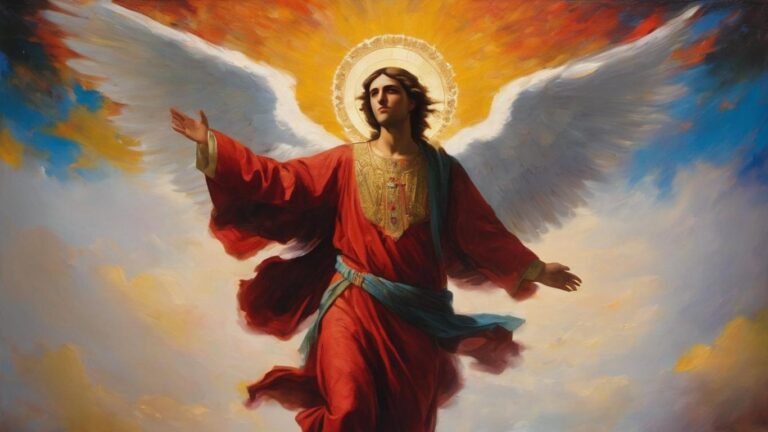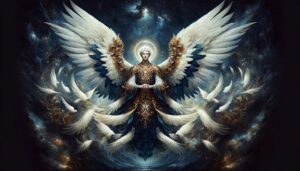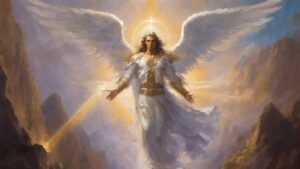Table of Contents
Across various religious traditions, Gabriel holds the esteemed title of an archangel, a divine messenger commissioned by God. His role extends significantly in Christianity, Judaism, and Islam. Renowned in Christian narratives for conveying pivotal messages, such as the announcement of Jesus’ birth to the Virgin Mary, Gabriel plays a vital role. In Islam, the angel Jibreel (known as Gabriel in Arabic) assumes a central position, serving as the conduit for the revelation of the Quran to Prophet Muhammad. Within Jewish traditions, Gabriel emerges as a celestial being and angelic messenger of considerable importance. The roles and significance attributed to Gabriel exhibit variations across diverse religious texts and interpretations.
Divine Messenger
Gabriel’s primary role is that of a messenger. In religious texts, Gabriel appears to prophets and chosen individuals, delivering important messages from the divine realm. The archangel’s name itself carries significance, translating to “God is my strength,” reflecting the power and authority inherent in the messages conveyed.
Biblical Significance
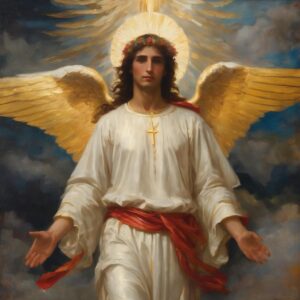
In the biblical narrative, Gabriel’s trumpet-like herald echoes across sacred annunciations, announcing the births of pivotal figures in the divine plan. During one such momentous occasion, the announcement of John the Baptist’s birth, Gabriel descends in a blaze of divine radiance to deliver the news to John’s parents, Zechariah and Elizabeth. This archangel’s proclamation sets the stage for John’s destined role as the precursor to the Messiah, marking the dawn of a transformative era.
However, it is Gabriel’s encounter with the Virgin Mary that etches an indelible mark on the biblical narrative. The angelic messenger descends with a message of profound consequence, revealing that Mary will conceive and bear the Son of God. This sacred annunciation, known as the Annunciation, heralds the incarnation of Jesus Christ, the central figure in Christian theology. Gabriel’s words, “Hail, favored one! The Lord is with you,” echo through millennia, encapsulating the divine connection between heaven and earth.
Gabriel, as the messenger in pivotal events, shapes the divine narrative. Angelic proclamations initiate events that fulfill prophecies, realizing God’s redemptive plan.
In biblical significance, Gabriel emerges as more than a messenger but as a celestial herald. Divine messages conveyed by Gabriel stand testament to the archangel’s integral role in the sacred narrative. Each utterance contributes to the unfolding drama of salvation and grace, resonating across time.
Islamic Tradition
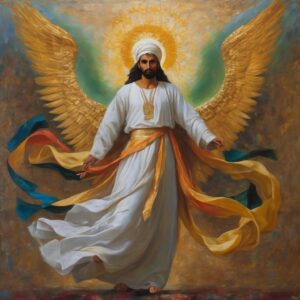
In the rich tapestry of Islamic tradition, Jibreel, known as Gabriel in the Judeo-Christian context, assumes unparalleled significance. Regarded as the angel of revelation, Jibreel serves as the divine intermediary, transmitting God’s words to Prophet Muhammad.
During the Night of Ascension, a pivotal event in Islamic spirituality, Jibreel and Prophet Muhammad share a momentous encounter. On this sacred night, Jibreel descends with a celestial purpose, delivering the revelation of the Quran to the chosen messenger of God. The divine words, encapsulated in the holy scripture, are conveyed through Jibreel, establishing a direct link between the heavens and the earthly realm.
Jibreel’s role as the bearer of divine revelation underscores his significance in the Islamic narrative. The Quran, considered the literal word of God, is revered as a timeless guide for Muslims worldwide. Through Jibreel’s angelic agency, the Quran becomes a manifestation of God’s guidance, offering profound insights into matters of faith, morality, and conduct.
The Night of Ascension, mirroring the significance of Gabriel’s appearances in other religious traditions, represents a pinnacle in Islamic spirituality. Jibreel’s descent becomes a conduit for the transmission of divine wisdom, shaping the foundations of Islamic theology and practice. The profound encounter with Jibreel during this night solidifies the Prophet Muhammad’s role as the final messenger and the Quran as the ultimate revelation.
In Islamic tradition, Jibreel’s celestial mission endures as a symbol of divine communication and guidance. His presence in the sacred Night of Ascension exemplifies the intimate connection between the divine and the human, a theme that resonates throughout Islamic spirituality.
Symbolism and Iconography

Steeped in symbolism and adorned with iconic attributes, the celestial messenger Gabriel encapsulates the essence of his divine role. Throughout artistic representations and religious depictions, Gabriel wears symbols that echo his function as a bearer of celestial messages.
A prevalent symbol accompanying Gabriel is the trumpet or horn, signifying the announcement of divine messages. This iconic attribute aligns with Gabriel’s role in delivering significant revelations, marking pivotal moments in religious narratives. The trumpet becomes a celestial instrument, heralding the arrival of divine decrees and shaping the course of sacred events.
Another symbol intricately woven into the depiction of Gabriel is the lily. The lily, synonymous with purity and grace, becomes a visual metaphor for the divine purity carried in the messages delivered by the angel. This symbolism is particularly prominent in depictions related to the Annunciation, where Gabriel announces to the Virgin Mary the miraculous conception of Jesus. The lily serves as a visual representation of the immaculate nature of this divine occurrence.
Artists and religious iconographers have masterfully crafted representations of Gabriel, capturing the nuanced symbolism associated with this celestial being. The trumpet, poised for proclamation, and the lily, held with grace, become powerful visual cues that evoke the divine aura surrounding Gabriel.
Gabriel’s attributes carry theological depth beyond artistic embellishment, symbolizing profound meanings. Moreover, the trumpet’s clarion call and the lily’s purity collectively represent the sacred nature of Gabriel’s cosmic role. These symbols, adorning artistic renditions, serve as potent reminders of celestial messages and the angelic presence woven into religious traditions.
Cultural Impact
Gabriel, the celestial messenger, transcends religious confines, leaving an indelible mark on human culture. His influence echoes in art, literature, and music, symbolizing hope, guidance, and a divine presence across diverse cultural landscapes.
In the realm of art, Gabriel has been a muse for countless artists throughout history. From Renaissance paintings to contemporary works, depictions of the archangel often evoke a sense of awe and inspiration. Artists have skillfully captured the ethereal nature of Gabriel, portraying the celestial messenger in scenes of divine announcements and sacred encounters. These artistic renditions serve not only as visual interpretations of religious narratives but also as timeless expressions of the archangel’s cultural significance.
Literature, too, has been deeply influenced by the character of Gabriel. Whether appearing in classical tales or modern novels, Gabriel’s presence adds layers of depth to narrative arcs. The archangel’s attributes of guidance and divine communication become powerful motifs, shaping characters and plotlines that resonate with themes of transcendence and spiritual awakening.
Gabriel’s influence extends into the realm of music, where the archangel is often invoked as a symbol of inspiration and divine intervention. Composers, lyricists, and musicians draw upon the archangel’s imagery to infuse their works with a sense of the sacred. From choral compositions to contemporary songs, Gabriel’s character becomes a muse for those seeking to convey themes of spiritual significance.
Essentially, Gabriel’s cultural impact attests to the enduring fascination with the intersection of the divine and human experience. Furthermore, the archangel’s portrayal in art, literature, and music acts as a bridge between the celestial and the terrestrial. This invites individuals from diverse backgrounds to delve into the profound themes embodied by this celestial messenger.
Guardian of Life Transitions

Gabriel, the celestial messenger, assumes a revered role as the guardian of life transitions across diverse traditions. Additionally, beyond his role as a messenger, Gabriel is portrayed as a compassionate guide through the pivotal moments of birth, death, and resurrection. This multifaceted aspect of the archangel’s character adds a layer of comfort and reassurance to his image.
During moments of birth, Gabriel is invoked as a protector and herald of new beginnings. His presence is seen as a source of divine comfort, overseeing the transition from one phase of life to another. Expectant mothers and families find solace in the belief that Gabriel watches over the entrance of new souls into the world.
In times of death, Gabriel’s role as a compassionate guide becomes pronounced. Traditionally viewed as the angel who escorts souls to the afterlife, Gabriel brings a sense of assurance and gentle guidance to those undergoing the profound transition from earthly existence to the spiritual realm.
Additionally, in narratives of resurrection or rebirth, Gabriel embodies the transformative process of renewal and awakening. This symbolic representation aligns Gabriel with the cycles of life, emphasizing his role as a guardian accompanying individuals through intricate spiritual journeys.
Furthermore, Gabriel’s guardianship over life transitions resonates universally, providing a symbol of hope during the complex tapestry of human existence. In this capacity, the archangel serves not just as a messenger but as a compassionate companion through the profound transitions that shape the human experience.
Contemporary Relevance
In today’s context, Gabriel’s symbolism resonates in the broader themes of communication, guidance, and divine intervention. The archangel serves as a timeless symbol of hope and connection with the divine, reminding believers of the celestial forces that guide and protect.
Whether in religious scripture, artistic masterpieces, or cultural symbolism, Gabriel, remains a compelling and enduring figure, bridging the celestial and earthly realms with messages of significance and grace.
